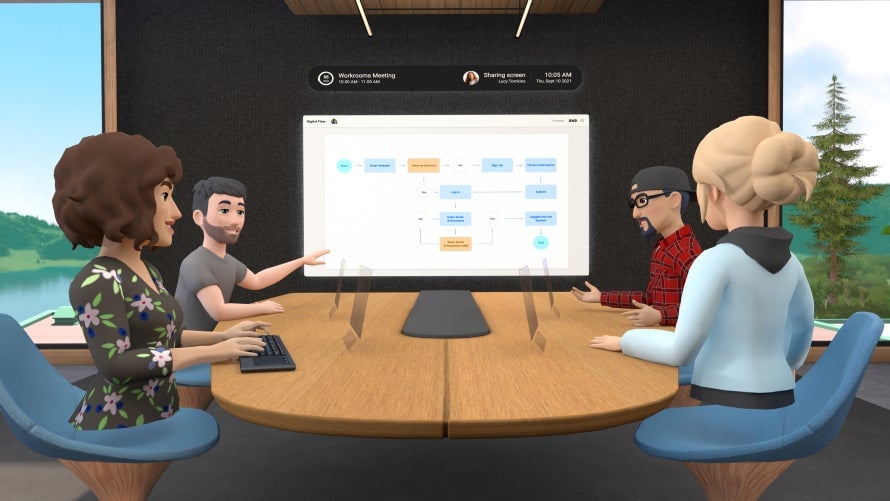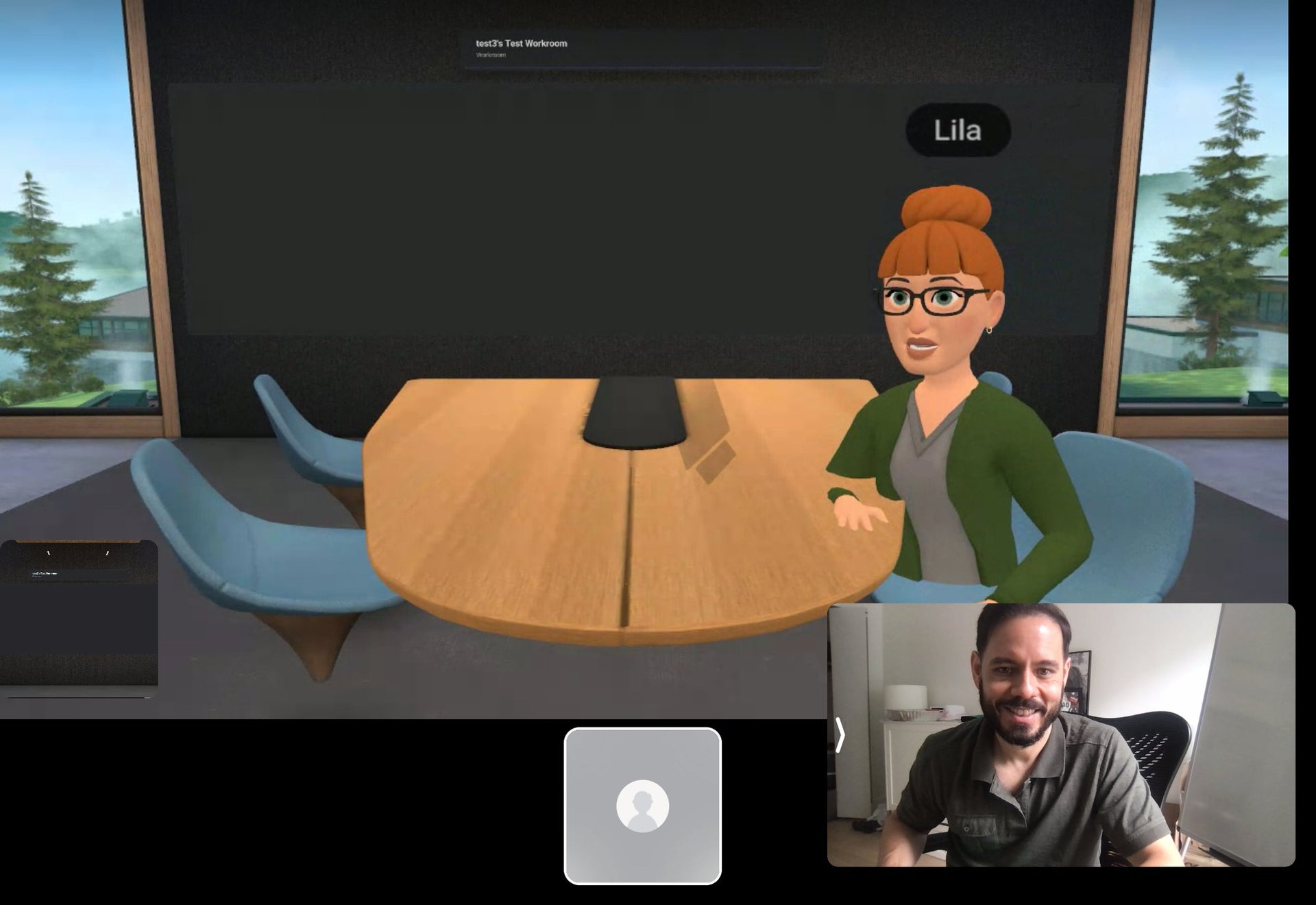Facebook Workrooms brings the worst of in-person office life to virtual reality
At this point in the pandemic, I would happily sit through a meeting that could have been an email if it meant being in the same room with a bunch of work friends. So when Facebook released Horizon Workrooms, an app that allows people to gather in a virtual-reality office, I was prepared to keep an open mind about its potential.


At this point in the pandemic, I would happily sit through a meeting that could have been an email if it meant being in the same room with a bunch of work friends. So when Facebook released Horizon Workrooms, an app that allows people to gather in a virtual-reality office, I was prepared to keep an open mind about its potential.
After all, humanity seems destined to one day leap into the metaverse, the internet we will not just use but inhabit, so why not check out a vision of what that might look like according to a powerful company that hopes to help shape it, for better or worse.
Only two other people at my office own, or will admit to owning, an Oculus Quest 2 headset, the $300 headset required to experience Workrooms in VR. Together we created a tiny focus group: This would be the first time we’d try to connect with others’ avatars in a virtual workspace.
The first Workrooms challenge: Finding your way into a virtual meeting
Fortunately for Facebook, people’s lasting impressions of experiences are heavily influenced by how they end and not how they begin. Unfortunately for us, our onboarding process was bumpy.
As the only Gen-Xer in the group, I worried I might live up to stereotypes about older employees being stumped by new technology, so I was mortified when I could not find my way into the first meeting room I was invited to join. Instead, I landed on the virtual screen that acts as a portal for non-virtual guests to attend any gathering, as if on a regular video call.
Looking through my headset, I could see my cartoon avatar waiting to be teleported. On my laptop screen, the avatar for Quartz’s CEO, a willing participant in our little experiment, sat alone. When I created a meeting room and invited him, we found ourselves in the same predicament, but with our roles reversed. (For the record, it’s surreal and somewhat embarrassing to be a dorky avatar staring up at the image of a real person on a video call-in screen. I understand why this feature has to exist when headsets are not yet in everyone’s tech arsenal, but I doubt that avatar-video hybrid meetings will be a hit.)

By our second attempt, I figured out what had gone wrong: Although it would seem intuitive to use your company email account to sign up for a workplace product, you actually need to log in with the same address you use for Facebook. This had not been obvious to me, nor to a third member of our group who also first appeared on the video screen in her headset. The takeaway: If you’re going to try Workrooms, be prepared to share your ancient hotmail address, or maybe a nickname that hasn’t been a part of your life since college, with your present-day peers and manager.
The second Workrooms challenge: “What are my arms doing now?”
Eventually, all three of us came together in the app’s conference room, where we initially spent some time checking out our digital bodies. The Oculus had warned us that “legs may not be possible” in every app, so it wasn’t exactly surprising to find our bodies disappeared into floating blue office chairs at about hip level, but it was distracting.
It turns out that this isn’t merely a result of Facebook rushing out a product a bit early, in VR, replicating legs that can walk or run is complicated, so they are absent in other VR meeting apps, too, including within the more graphically rich Spatial app, and in MeetinVR.
You might imagine then that one’s virtual arms would compensate for the missing bottom limbs, but in Workrooms, they were instead unwieldy at times, often busy with their own projects underneath our virtual conference room table, or hanging in mid-air.
The app insists that users turn on hand tracking so your plastic controllers can be used as whiteboard pens, but the hand and finger functions seem glitchy and frustrating. To pick something up or select from menu items, you’re supposed to make a pinching motion with your real fingers, which takes practice. At times we appeared to lose our CEO’s attention as his avatar stared at his hands grabbing the air, seemingly catching flies Karate Kid-style.
What we liked about our virtual conference
Next, we checked out all the things our avatars could do in the program’s bright, extremely generic conference room. Considering the resources Facebook would have at its disposal, we found the list of impressive in-app features surprisingly short. Here’s what we liked:
- Workrooms uses spatial audio, which means your colleague’s voice sounds like it’s coming from the right direction relative to where they are virtually seated. That effect is likely the key reason it feels as though you are present with others when you’re chatting, and turning your head in the right direction to “look” at other avatars. This alone is a huge improvement over the choppy, unidirectional quality of a standard video call. (No one in our group experienced any nausea or dizziness during our trial meeting, so there’s also that.)
- Above the virtual desk or table, every user has a Passthrough window, a space that allows people to see through the VR environment to their own actual room or surroundings. This handy slot allows you to see your real desk, where you might have your laptop or phone, without removing your headset.
- Players can stand at the whiteboard when they need to give a presentation, a trick that isn’t interesting on its own. However, to get to the whiteboard, you have to physically stand up and walk a few feet in your remote room. Until you try this, you may not realize that you miss having a reason to stand up and walk around during a discussion at work. Zoom and other two-dimensional office apps pretty much demand that users stay still.
- Finally, an in-app optional add-on program, the Oculus Remote Desktop, allows a person to access a virtual version of their real laptop from within a Workroom meeting. VR meeting attendees can also pull in notes and files to share in the conference room.
What’s not to like about Facebook’s metaverse
By adding the remote desktop, a person could, in theory, spend their entire day working inside this other reality, popping in and out of virtual meetings. However, it’s unlikely that anyone would actually want to do that. After about 20 minutes, the Oculus 2 headset becomes hot and heavy on a person’s face. Long meetings would also mean charging the hardware periodically because Workrooms seems to tax the battery.
But beyond the physical limitations, there’s a bigger problem: The virtual rooms are so dull that a person would quickly run out of reasons to stay there.
🎧 For more intel on the modern office, listen to the Quartz Obsession podcast episode on office chairs. Or subscribe via: Apple Podcasts | Spotify | Google | Stitcher.
Yes, you can switch up the seating arrangement so that you’re facing your peers or taking in a presentation, and you can jump into a new seat in a blink just to view the room from different angles, but that’s really all there is. You cannot huddle around a coffee bar for an informal chat, bond over foosball, or lounge in a Moon Pod.
Workrooms, in other words, only recreates the things we don’t miss about office meetings, like the opportunity to watch someone give a PowerPoint presentation. Somehow, the world’s biggest social media site forgot to make its latest product social. And without unstructured time in the company of others in VR or elsewhere, it’s hard to imagine having the kinds of conversations that lead to creative breakthroughs and keep people motivated, or get people interested in the metaverse.
Metaverse? Meh-taverse
While it may be unfair to mock the details that will surely be refined as the software moves out of beta—for example, how are the perpetually pleasant half-smiles on the avatars’ faces going to land during serious discussions?—the app’s dry focus on a corporate ritual is a let-down. We definitely expected to find more than an unremarkable conference room in the first virtual space Facebook has debuted since Zuckerberg’s ode to the metaverse on an earnings call.
Still, I had to admit when I peeled off my headset that it felt like I actually had been somewhere else, with other people, for a change.
The virtual trip was not as energizing as the real visit to the office I made before the delta variant began surging, and I think we will need more private spaces if we’re actually going to socialize in a virtual office. But I do understand the optimistic forecasts that say the enterprise VR market will expand, possibly reaching $4 billion by 2023. (A few big firms, including PwC, have already begun experimenting with VR meetings.)
It’s not a bad bet given the future that awaits us. One day, VR goggles might be lighter and the graphics less clumsy than they are today, but office closures during grim public health crises or devastating climate events may be just as common.